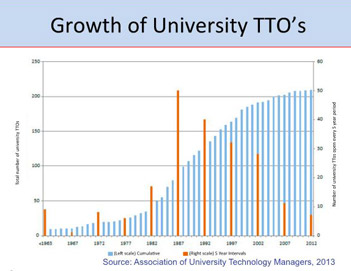Mike Tymianski Bench to
Bedside is not as Easy as it
Sounds…But it’s Possible -
The Story of NoNO
“There are approximately 17 million strokes per year
throughout the world -50,000 per year in Canada. The
standard therapy is to ‘fix the pipes’ - to treat the arteries
that might be blocked or sending clots or debris to
the brain. This is done with a clot busting medication
(tPA) or with endovascular devices used to mechanically
retrieve the clots. Both have limited application due to
the potential complications of tPA, and the technology
intensiveness needed for endovascular therapy. But
research to develop new or better treatments is not easy.
“The way that one begins to develop a stroke cure is to
get a grant. This was our start case, when we developed
a promising new treatment: a competitive inhibitor of
the neuronal protein PSD95, which protects rats from
stroke by preventing the progression of ischemic damage.
The next typical step is to disclose your findings to
your institution and they will ‘do the heavy lifting for
you’, i.e. they will protect your intellectual property and
facilitate the process of gaining a patent, and then take
50 to 70% of the money earned by the invention. Tech
transfer offices providing these services have been proliferating,
but 87% of them don’t make their expenses.
“Pharmaceutical companies in general are not keen on
developing stroke damage reduction medications because of
the miserable record of failure of past clinical trials. There
are over one thousand rat stroke cures and no human stroke
cures. We are, so to speak, in a ‘nuclear winter of stroke
treatment”. Mike Tymianski went to Chris Page and Bob
Bell at UHN with the proposal that he would start his own
company - NoNo Inc., and do the heavy lifting himself.
UHN could become a shareholder, but the company would
own the intellectual property. They agreed.
“There is a misconception that there is no money
available in Canada for investment. In fact there is very
substantial money available. Investors tend to put it in
the resource and financial sector, whereas biotechnology
investment is minor in Canada. Nonetheless it can be
extremely rewarding if a health technology is successful,
but the success rate is relatively low.
“As part of our drug development strategy we conducted
seminal studies in cynomolgus monkeys and
published our work in Nature. Even with this, big
pharma is only interested if the results are robust, reproducible, the drug has a clear and validated mechanism of
action, and the drug is safe. Reluctance from Pharma to
invest otherwise is due to very low rates of reproducibility
of certain drug data, and poor science. For example, a
small proportion of research studies are blinded and very
few have reliable statistical methods. They want certainty
about the mechanism of action of any new drug.
“Only one in 1000 drug discoveries leads to a phase 1
clinical trial. Once a phase 1 trial is underway only two
thirds get to phase 2, and if a phase 2 trial is positive,
one third get to phase 3. Then, only about two thirds of
phase 3 trials are positive. Of those, the FDA approves
about 85% of drugs, as they sometimes disagree with the
conduct of the phase 3 trial. The approval rates are lowest
for new drugs (as compared with re-purposed drugs),
and lowest for neurology drugs of all drug categories.”
|
PROVING EFFICACY
There is a small, but measurable area of damage that is
very subtle but frequent in the surrounding brain when an
aneurysm is treated by endovascular means. Mike and his
colleagues decided to study these mini- strokes to test efficacy.
They studied 185 patients in a multi-center randomized,
placebo controlled trial and found that patients who
received the PSD95 inhibitor drug NA-1, had 50% fewer
strokes than those who received placebo. They’re now
doing pivotal trials to prove benefit. One involves giving
NA-1 or placebo in the ambulance to patients with suspected
stroke on the way to 5 stroke centers in Toronto,
Peel and Vancouver. This trial significantly involves the
emergency medical services (EMS) personnel who give
the drug within 60 minutes. In the first 75 patients, they
met this goal. “EMS personnel are very keen on this trial
because now they are actively involved in treatment, not
just lorry drivers bringing untreated stroke patients into
the hospital for treatment. We are now training thousands
of emergency medical service personnel. A second trial,
set to start this year, will administer NA-1 or placebo to
patients who undergo endovascular stroke therapy at several
centers in Canada, the USA and Europe.
Many years ago insulin was developed in the laboratory
and taken to clinical use (remarkably) within seven
months. We are now taking a laboratory discovery to the
clinic, but our transition interval was 25 years. ”
M.M.

Growth of University TTO’s
|